We’ve all been there before: you and a few friends sitting around the table, working to save the world. Sometimes it's from worldwide diseases (Pandemic), while other times it's from reckless colonialization (Spirit Island). Maybe you’re just trying to survive a zombie apocalypse together (Zombicide), or stop a city from being devoured by darkness (Gloomhaven). These are all great games that try and tackle the cooperative genre of board game, making game mechanics that are interesting while giving you visuals that immerse you into the theme.
Tesseract throws all of that out the window and does something exciting. It leans into more abstract ideas of game design, stripping away giant set ups of miniatures and maps and replaces it all with a singular question: what if we made our game a pile of dice that’s shaped into a cube?
What Is A Tesseract And Why Is It Ticking?
The entire game boils down to this: there are 64 dice stacked into a massive cube in the middle of the table. There are four colors of dice split evenly in the cube, and it’s up to you and possibly three other friends to collect dice into four sets: you need six dice of each color, each color set having the numbers 1-6 represented. You take dice off the cube, one at a time, manipulating them on your playerboard until you have a set, and then add one to your win condition. Easy!

A perfect word for Sci-Fi shows and books to mean whatever you want it to mean! Also, usually proof that something is about to get strange. Definition taken from Merriam-Webster.
The problem is that between each player’s turn, the cube removes a die from the tesseract, signaling it counting down towards an explosion that warps the fabric of space-time and deletes earth. If the cube is ever fully dismantled, you and your scientist friends have run out of time, and it's game over for Earth. The dice that are removed are stored in an area signaling ‘primed’ dice, aka ready to explode. If three of the same number ever stack up, it creates a Breach, signaling the tesseract is getting ready to detonate. Get seven breaches, and its instant game over.
Without getting deep into the rules, what this means game-wise is that your paltry three actions a turn are more precious than gold. You have to carefully decide if you want to remove a cube to ‘study’ it and prepare to move it into that collection of 24 dice you need to win, or if you need to manipulate the already primed dice so Breaches don’t happen. Spend too long stopping breaches, and you’ll fall behind on actually winning. Remove cubes in the wrong order or too hastily, and you are actually speeding up the end of the game.
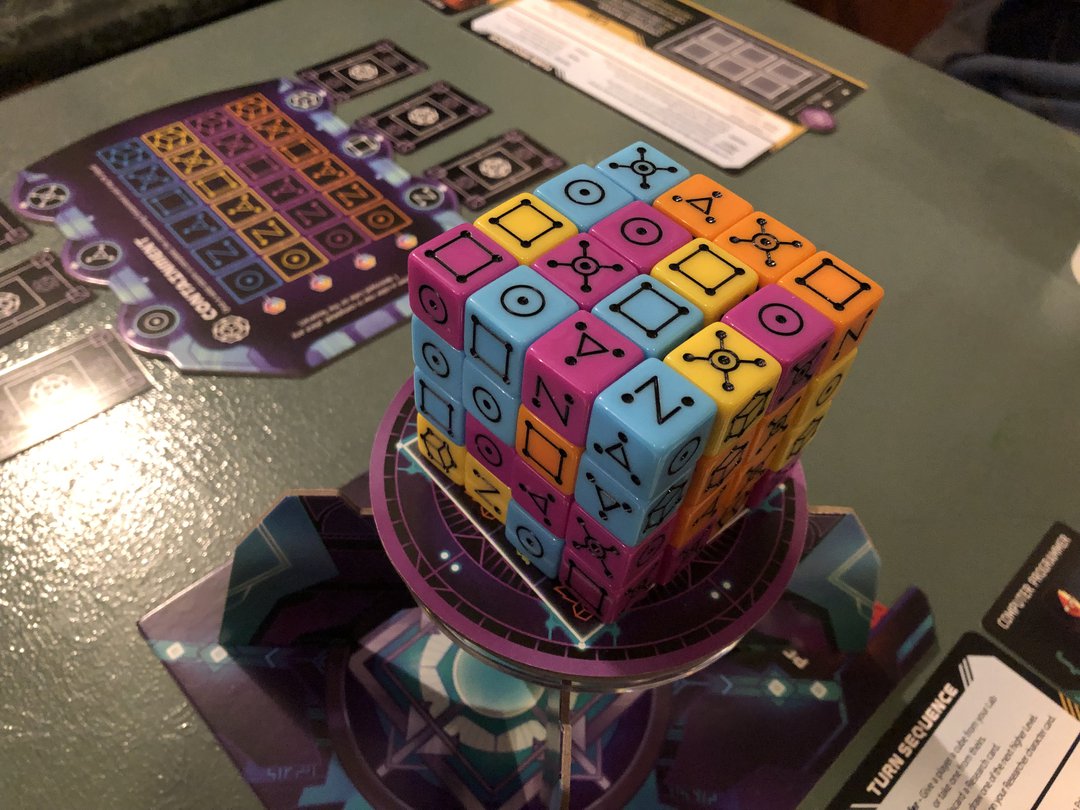
If the turn order sounds familiar, it's because Tesseract follows many of the same tropes and game mechanics that other cooperative games already pioneered. However, I can’t say enough how this game feels so very different to other board games, all because of a few smart design choices.
Don’t Underestimate The Power Of The Third Dimension
I really enjoy Tesseract because it's so very upfront about what the game’s gimmick is, and it makes sure that the gimmick is the best selling point. This is a game that could have been lost in the weeds thanks to being too abstract or being just another cooperative game that follows a pattern. Instead, simply making the board and the puzzle itself three dimensional elevates it.
Every time I’ve pulled out this game in a public setting, someone stops by to watch, to ask ‘hey what’s that you’re playing’? Board games have a hard job of trying to take big concepts like war or industry and making them palpable with cards or dice, but Tesseract succeeds just by taking 64 standard dice and stacking them on top of each other. There’s also a Jenga-esque effect that happens: the team decides that the best move is to take the purple four from the top corner. Everyone tenses up, even sometimes holding their breath, as the current player reaches to carefully pull the cube free. An exhalation of relief can be heard as a player manages to disarm a set of primed dice that were ready to go off, or someone uses a special ability to stop what is about to be a disaster from happening.
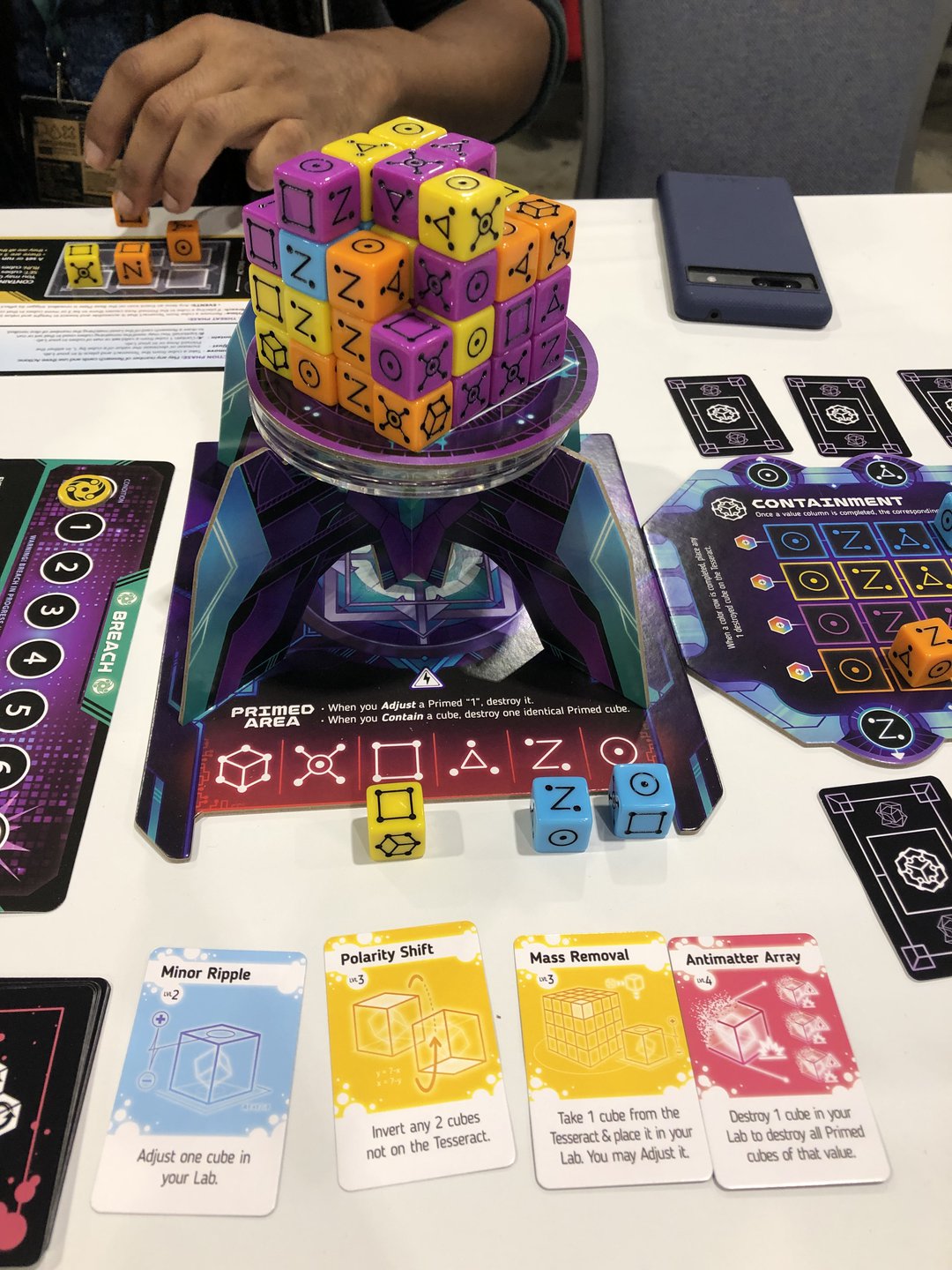
Us playing Tesseract at PAX Unplugged last year, same day we got it. Ended up playing twice, almost to closing time.
If there is one thing Tesseract succeeds at, it’s managing to take the seven sentences of theming in the manual and create something engaging and captivating.
The Black Hole Is In The Details
There is more fluff sprinkled smartly throughout the game by using science-adjacent language, constantly reminding you of the stakes. The player boards where you manipulate dice is called a lab. The cards you can be awarded through clever play for extra abilities are called research. When you start a game, you are dealt out researcher roles, each of which give you an extra ability and improved benefit. You’ll be familiar with this part if you’ve ever played Pandemic, but they have names like ‘Quantum Mechanic’ and ‘Transport Engineer’.
These extra abilities are key because it lets you break the game to get desperately needed advantages. You usually only get three actions in one turn, so any chance to become more efficient is necessary, or you are likely to lose. For example, taking a die from the tesseract and then adjusting the die facing to a different number would be two actions. However, the Transport Engineer explicitly says when they take a cube, they can adjust it for free.
This does a number of things to how the game plays. The advantages a role card gives you are incredibly powerful, and really push people to become specialized in what they are doing for that game. There are eight different roles: I’ve ended up as the Demolitions Expert at least twice, which loves to destroy primed cubes before they cause breaches. The Astronomer suddenly makes it so research cards can be tossed around like candy, and so on. Secondly, thanks to how the game is constructed, it really, really forces active cooperation. When I spoke with Curt Covert, the owner of Smirk and Dagger Games and publisher of Tesseract at last year’s PAX Unplugged, he stated how if you don’t communicate, if you don’t work on making the most of each other’s turns, not just your own, you will probably lose every game. I’d be inclined to agree.
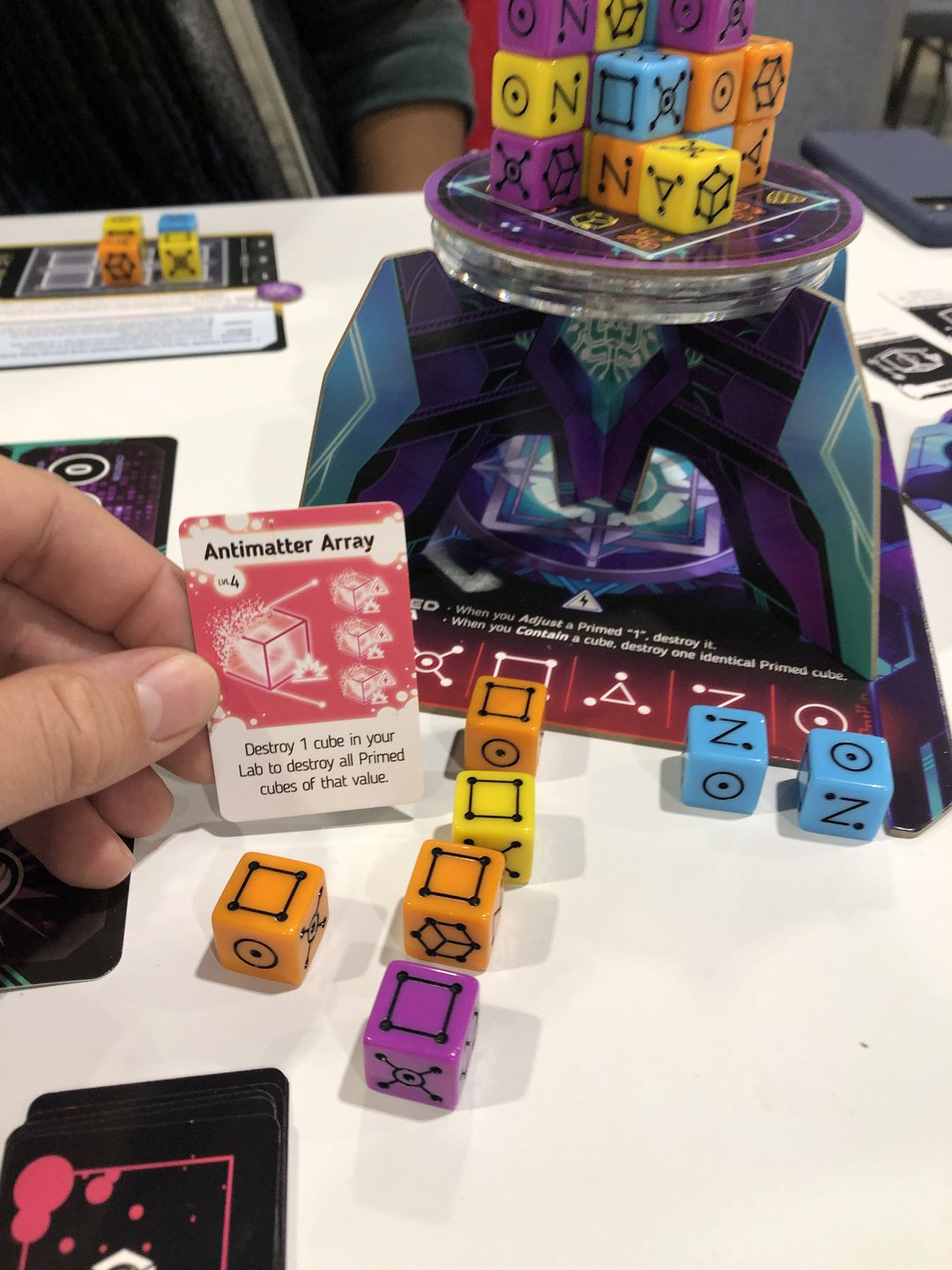
What you see here is us loading up the primed area with the number 4, and then using research to blow it up before we immediately lose. Risky and needed a lot of coordination, but worth it.
On the other side of the table, the cube itself gets a little superpower as well to fight back. You see, when you first set up the game, one of eight base plates are put down where the cube goes on the table. When dice are removed on the tesseract’s turn, they always pick the exposed one lowest to the table. When a full column is removed, it reveals a symbol which represents something fun like ‘chain reaction’, which destroys more cubes or makes it more likely for there to be a breach.
All these little wrinkles and complications to the standard ‘three-actions-then-the-tesseract-goes’ keeps the pressure and tension going all game long.
Some Words Of Warning Before Attempting Quantum Physics
While I think Tesseract is a triumph in many ways, I do have to spend a little time nitpicking it in a few places. Namely, this is just so you understand the sort of game you are getting yourself into, as I think you’ll either really enjoy this game or it might not be for you.
If I wanted to be derivative, I would just say that Tesseract is like most standard cooperative games (Pandemic, Spirit Island, etc), but made 3D. A player takes a turn, the board state gets a little worse, rinse and repeat. If you are a fan of that sort of game and want a new challenge, great! If you like that game style, this game does to re-invent the genre to feel fresh for multiple plays. However, if you are not into cooperative games, this follows that standard formula enough that I couldn’t recommend it to you.
Branching off of that, we need to get into the thorny question that plagues all cooperative games: is it too difficult, or is it too easy? When talking with Curt, he mentioned how the game should be pretty tough for people, and expect about a 40% win rate for players who are attempting games. Was he correct? We absolutely got crushed our very first game as we figured out the cadence and pacing at a 4-player count, but after two friends left, I had an intense 2 player game of it where we won, high fiving after working hard to break the puzzle and see how it all worked.
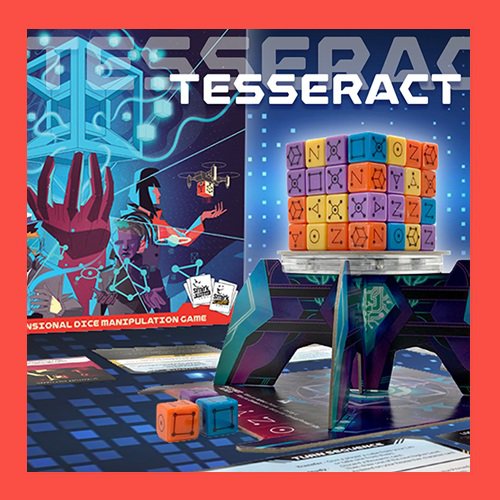
It goes without saying, this is a game that needs to be played on a flat, stable surface. This isn’t a problem for most, but for those who might have a lot of kids or pets around, just a heads up.
In the end, I’ve played seven games of Tesseract and taught a few more, and would say the win rate I got was about 67%. That’s a lot higher than what we were told, but I can explain. One, the board game group I run locally really enjoys cooperative games as a whole, and so we figured out the game faster than maybe some others would. The second reason is because I was often teaching the game to different players, we kept playing on the lower difficulty base plates; the four most difficult plates add in tougher effects and can create more chaos, but with at least one or two people at a table who had played a few times before, victory seemed very much possible each game.
I will say that Tesseract does a great job of showing off tension, more than many cooperative games I’ve played. Watching the cube get smaller and smaller, being taken apart by your actions and the game itself… We often would count up how many dice were left just to see how close we were to losing. Three dice? Six? Twelve? The game feels tense, capturing that feeling that you need to make each move count.
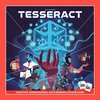 Tesseract
Tesseract
Author: James Firnhaber
Designer: Smirk & Dagger Games
Format: Board Game
Number of Players: 1-4 Players
Play Time: 60-90 Minutes
Price: $55
Review Copy: This game was reviewed with a copy given by the publisher
The third detractor to difficulty is probably the one that plagues most games of this genre: some roles you are dealt are just strong, maybe too strong. The Astronomer lets you outright take research cards that would normally take players a lot of effort to get by arranging extra dice in their labs. If you pair this up with the Field Researcher, who gets to trigger research cards twice… we did have one game where we pulled this off and by midgame, all the tension had been sucked out of the room.
In the end, I think the game isn’t too easy or too hard, but I feel that for experts with cooperative games who want a real challenge, you might need to bump up the difficulty pretty quick and maybe have some house rules not to use certain combos you find and break during your experimentation. The last warning I would give is just that unfortunately, due to the nature of the game and the dice, someone who is colorblind might have a hard time with this game, and I'm not sure how to work around that.
Hail Science!
I really love Tesseract. I played the heck out of it after first getting it, cooled on it after we found a few strong combinations, and now I’m back again ready to keep playing. I was worried at first that it was going to feel like too much of a gimmick, but there is lasting value here, as I want to jump back in still after a half dozen games. It has quality components, a moderately sized box with a good game insert, and is $55. It means Tesseract isn’t cheap, but it isn’t a luxury over-produced purchase like many games these days can be. It plays really well at two, three, or four players, and as a solo game has the same meditative feel as Solitaire or a good crossword puzzle gives you, but much more in depth.
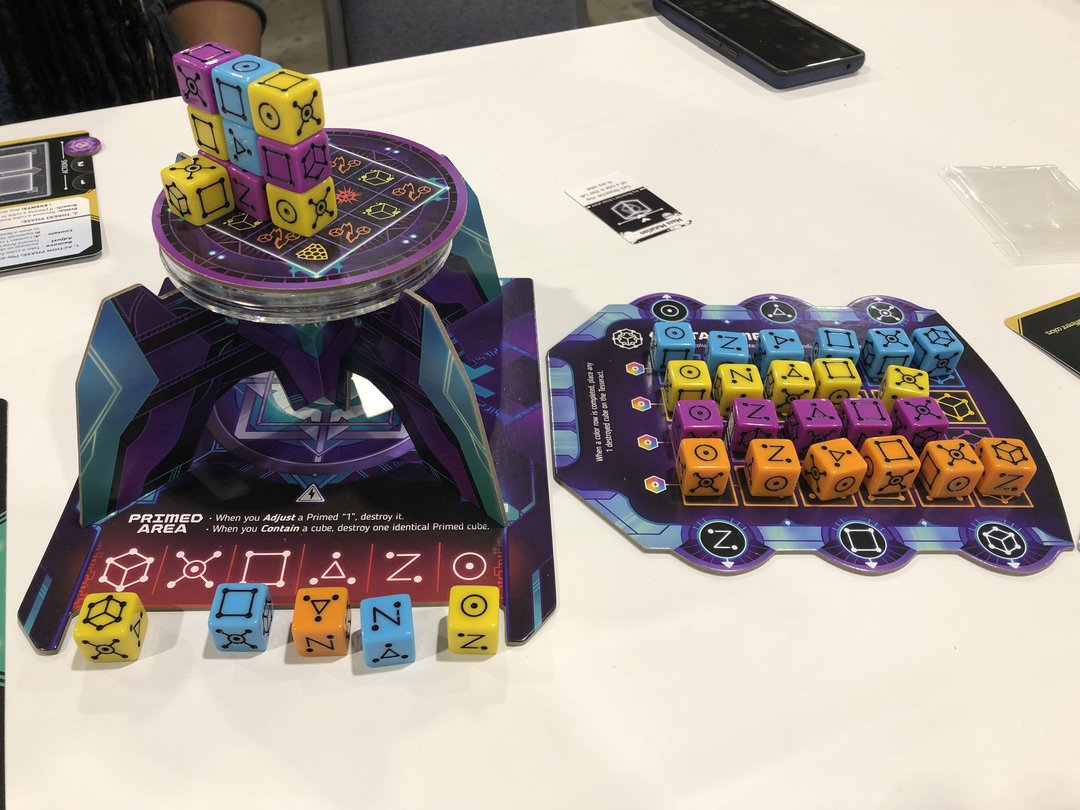
Nearing the end and almost at a victory. Still, seeing so few dice left can keep you bracing for things to go wrong right until the finish.
At the end of the day, I have to return to one of my original thoughts. Just look at how this game is set up: if you were to walk by it set up, would it intrigue you? Does the idea of a 3D puzzle that slowly breaks itself apart make you want to try it? Then Tesseract is probably right up your alley. In an age where there are so many games that bury their selling point into heavy rulesets or have an incredibly simple gimmick, this game is refreshing in how it says right up front what it is trying to do, and then accomplishes its goal.
Now if you excuse me, I’m off to try and save the world again, this time at difficulty 8. Wish us luck.